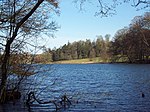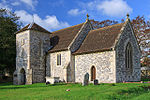Fonthill Bishop

Fonthill Bishop is a small village and civil parish in Wiltshire, England, to the north of the Nadder valley and 9 miles (14 km) south of Warminster. The Fonthill Park estate extends into the south of the parish. Landscaping which included the creation of Fonthill Lake was begun in 1740 by William Beckford (later Lord Mayor of London) and continued from c. 1793 by his son William Thomas Beckford, who built Fonthill Abbey, now almost completely demolished. The estate now belongs to Alastair Morrison, 3rd Baron Margadale. Next to the lake (but outside the parish) is the Fonthill Grottoes Site of Special Scientific Interest. Part of the Great Ridge Wood lies in the north of the parish.
Excerpt from the Wikipedia article Fonthill Bishop (License: CC BY-SA 3.0, Authors, Images).Fonthill Bishop
B3089,
Geographical coordinates (GPS) Address Nearby Places Show on map
Geographical coordinates (GPS)
| Latitude | Longitude |
|---|---|
| N 51.096 ° | E -2.094 ° |
Address
All Saints
B3089
SP3 5SF , Fonthill Bishop
England, United Kingdom
Open on Google Maps











